by Jean Houston–
Interview and commentary by Ani Williams
“One of the potencies of The Odyssey lies in its origins:
It is bardic. People spoke and sang this great poem.
We charge and change the brain when we sing and chant.”
All article quotes by Jean Houston
This interview with Jean was recorded Spring Equinox 2009 and edited on the New Moon December 14, 2009, the birthday of the esteemed cultural anthropologist Margaret Mead. There are no accidents in the timing of things, as Mead helped launch an entire life’s work for a young Jean Houston. In her early life, Jean spent considerable time with the great mythologist Joseph Campbell, the philosopher and mystic Teilhard de Chardin and was the adopted daughter of Margaret Mead.
Honey Voiced Sirens of the Sea
Jean’s new book adds in depth commentary and meaning to Homer’s Odyssey, a three thousand year old story that serves as a metaphor for humanity in our changing world. It is the hero’s journey undertaken by King Odysseus, as he attempts to return home to Ithaca and his beloved Penelope after the Trojan War. Guided by the magic of the ‘Way-finder’ Hermes and the wisdom of his guardian Goddess Athena, Odysseus becomes engaged in a series of initiations by the goddesses of the islands he visits on his long journey by sea.
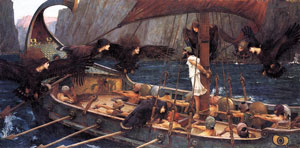
Odysseus is enchanted by seductive sirens and their honey sweet voices. According to the ancient Greeks, the sirens were related to wild bees and priestesses of purification. Jean writes that the sirens’ role is similar to the snake of Eden and the desire to understand the patterns that rule existence….”the yearning to hear the music of the spheres.” Along his journey, Odysseus is lured to the island of Circe, a siren skilled in the arts of medicine, magic and the power of transformation. Then he encounters Calypso, the nurturing, consuming lover, and he tarries in her realm for seven years.
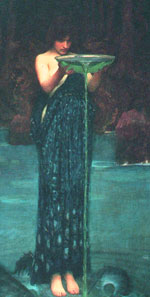
These siren goddesses initiate our hero and a grand transformation occurs, as he moves from the self-serving power seeking male to the possible human with a vision for the good of the kingdom and all its inhabitants. But the transformation is not just for Odysseus; the goddess-sirens are also changed in the process through the alchemy of love. As Jean says in the book, “From their partnership we can learn patterns for creating or restoring a sense of the deep connections that are possible between our mortal and the immortal realities.”
This is a story for our time and a guidebook for the ‘Possible Human’.
Ani: In the foreword by Marianne Williamson, she said that one of your specialties is mining the gold of mythological and literary figures for their personal relevance for each one of us. A unique thing about this book is that it has to be experienced; you don’t just read it, you have all the exercises that are there.
Jean: Well, I think that as you read the exercises, they are written in such a way that hopefully they will engage your mind and the inner sensibilities that enable you to actually undergo the process. Best of all, is to be with a group of people and do them together. You might ask why I’ve written hundreds of these exercises. The reason for this in part, is because Margaret Mead said to me on her deathbed:
“Listen, I am lying here being an anthropologist regarding my own dying. The fascinating thing is, there is no hierarchy to it and I see that if we are going to grow and green in our time, it’s a question of people getting together and teaching and learning in communities.”
And she said, “Doing your kinds of processes, Jean, teaches others to grow in body, mind and psyche. And then from that depth and breadth of their growth together, they can then choose projects to go out and make a difference. And when the time is right (she said this in 1978), you will go out and do this.” I said, “Yes ma’am, I will.”
So I began to write many books that had not only cognitive content, but experiential content. And to live through the story of Odysseus, in many ways the first modern human being, because with his mind and with his intellect, he can understand almost anything, but he lacks access to the depths. And so the story really is about how he gains access to his own inner capacities, as a result of always being shipwrecked on the islands.
A: Like the soul shipwrecked in the current world today….both male and female. And if the men can be transformed and retrieved by this work, fantastic.
J: Well, this is why I wrote a book that is for both men and women, but the men particularly seem to respond to it, because it is about one of the great archetypal heroes of all time.
The Garden as Metaphor for Transformation
“Planting new human beings is what we are doing,
because we can no longer live in the archaic forms that
we have been living, as partial versions of who and what we are.”
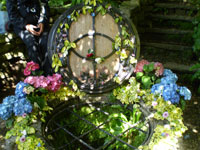
A: I love the way the story moves from Odysseus’ warrior pride to the sensitive male going through the initiations of the goddess. And the way you use the term ‘becoming humus in the garden’, breaking down everything to make good compost, because, certainly now at this time we need a lot of compost to grow something new. I get such hope when I read the words in this book. A new dream, based on an ancient tale, using the arts, reclaiming beauty. It seems like the story is a metaphor for planting a garden of new human beings.
J: Well that is what my life’s work is, in many countries, many cultures. Essentially, planting new human beings is what we are doing, because we can no longer live in the archaic forms that we have been living, as partial versions of who and what we are. And for the possible society and the possible world to take place, you need the possibilities of our deep humanity realized.
So I have spent over forty years in studying human development and now human development in the light of social change. I have been sent out to work with leadership in many countries, because most leadership has been white males in an old paradigm.
A: You mention in the book the industrial era and a deep forgetfulness that ensues. That we were conditioned to remove the sense of great mystery from life and it seems that this work can help to reclaim that.
J: Well, we have become autistic with regard to nature and the higher mysteries of life during the long industrial night that we have been suffering from. I don’t find this as much in developing countries to the same degree. But there you have the problems of colonization and of course certain kinds of unfortunate decadence as a result of colonization.
 But we are in the most interesting time of human history. I’m something of a cultural historian, and I have to say that in all my studies there is nothing, nothing that approaches the singularity and uniqueness of this moment. Where and what we do will make a profound difference in whether we grow or die.
But we are in the most interesting time of human history. I’m something of a cultural historian, and I have to say that in all my studies there is nothing, nothing that approaches the singularity and uniqueness of this moment. Where and what we do will make a profound difference in whether we grow or die.
That is why I take people on this journey of the soul, weaving all kinds of processes and experiences through the stories of the great journeys. Because we are ourselves Odysseus, the hero or heroine of a thousand faces. We live lives surely as mythic as theirs. We live five to ten and in some cases a hundred times more in the amount of sheer experiences than our ancestors of fifty or a hundred years ago.
A: Yes, it is extraordinary. You mention Joseph Campbell’s book Hero of a Thousand Faces, which has inspired so many….
J: He was a research subject of mine by the way, as was Buckminster Fuller. Joseph and I worked together for over twenty years.
A: Brilliant! What a profound connection that must have been. You mention that he influenced your early years.
J: Yes, and he kept coming back into my life in various ways. I’ve been extraordinarily blessed to be in the right place at the right time to have been able to meet some truly great people. It has been a kind of miracle really. I was Margaret Mead’s adopted daughter.
A Run-In with a Great Mystic
“Don’t you know you will one day become a butterfly…
it is part of your entelechy, your divine deep purpose, your inner guidance”
Teilhard de Chardin
A: Because you had a big work to do, you had to meet big minds and great souls. Tell me about your meeting with Teilhard de Chardin.
J: Actually, I quite literally ran into him when I was fourteen years old. He lived very near me in New York and one day I was running down Park Avenue late for school and I knocked him down. I helped him up and he said, “Are you planning to run that way for the rest of your life?” I said, “Yes sir, it looks like that.” He said “Bon voyage.” and I continued to school.

Then one week I was walking my fox terrier through Central Park and there was Msr. Teilhard again. He suggested he join me for a walk and we walked together quite often for the next three years. He would tell me parables, like the caterpillar and its changing, metamorphosis. He would say, “Don’t you know you will one day become a butterfly…it is part of your entelechy, your divine deep purpose, your inner guidance”.
I responded to him with, “Well then, when I become a butterfly, I’ll fly around the world and help people.” The last time I saw him before he passed away, I brought him the shell of a snail. He said “Oh, escargot!” and began to talk about spirals, and about the floor in Chartres Cathedral. And from that inspiration, I went on to start the whole labyrinth movement. And he talked about the galaxies that spiral and the patterns of flowers…that it was all the great spiral of the human journey.
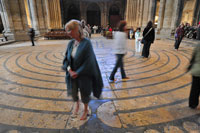
That was April 7, 1955. I said, “Goodbye Msr. Teilhard, I’ll see you next Tuesday.” He smiled and walked away. But my dog didn’t want to leave and kept whining in his direction because he knew something. Next Tuesday I was waiting for him, but he didn’t come. He had died that Easter Sunday, April 10th. And all that time, I never knew who he was. He did not use the name de Chardin. Teilhard de Chardin means ‘digger of the garden’.
It was years later in graduate school, that a friend had given me a book with no cover called The Phenomena of Man by Teilhard de Chardin. I read it, and here was my past, all the subjects he spoke about: Metamorphosis, the noosphere, spirals. When my friend finally gave me the cover, there was his picture, my old friend, and I finally knew who he was.
A: What a blessing on your path. Amazing. Too bad you didn’t have a tape recorder in your pocket during those precious sessions with him over the years.
J: Well, what I did have was a pen and a notebook, which my father had always told me to carry so that whenever I saw anything interesting, to write it down. That is how I was able to write about him later. I would take notes as we were walking. Fortunately I kept all those old notebooks. Margaret Mead did the same thing. She kept very thick, small red books and any important thought, she would write it down.
The Power of Myths as World Creating Codons
“Myths serve as source patterns originating in the ground of our being.”
A: In the preface to The Hero and the Goddess, you mention that all great stories have power coded in them that help us change our lives, and by changing our lives, change the world. And I love what you write next, that from the partnership formed by the hero and the goddess, we can learn patterns for creating and restoring a sense of connectedness. What I understood from this, is that in addition to the partnership of the Hero and the Goddess, it is the relationship of mortal and immortal realities. I have noticed a pattern recently in news broadcasts, popular films, that says people are searching for that mystical unseen reality. It seems to be a theme now. Can you say something about that?
J: Well, the ‘zeit’ is getting ‘geisty’! (we both laugh). And I think the spirit of our time has not been seen since the 6th, 5th centuries B.C. Within a hundred years, you had Buddha, Lao Tsu, Zoroaster, Pythagoras, and probably Confucius, these extraordinary unfoldings of spiritual genius, but now it is democratized. And when this brilliance comes along, it rarely rises in a democratic environment, as far as we know. Except when you have real need, the terrible necessity that we have now, because we have problems that are so enormous that by ourselves, even with our most ingenious inventions and contraptions, we are not going to solve them.
I think the depth is arising, or we are accessing the depths that have always been there, the kingdom in the midst. We are accessing the patterns and paradigms of that deeper kingdom, in which things work…the pattern that connects the potential, the blueprints are there in order to redeem the time, redeem the unborn vision of a higher dream.
The metaphor that is so popular these days is of the journey of the caterpillar into a butterfly. All the while, the caterpillar is saying “no, no, no, impossible!” And in the cocoon, “how is this mushy mess supposed to become anything?” But you have imaginal cells, guidance cells, intelligent cells that recall how to transform. These intelligent cells know how to use the mush as the nutrients that produce the butterfly.
In a sense, we are absolutely in the ‘mush’, of the breakdown of all the old orders. We are making humus and out of this there are these forms of both the quest for higher guidance and perhaps the rise of it—the great dynamic, earth creating, world creating codons, some of which are rising in our time in the most extraordinary way. I find that really quite remarkable.
And this movement is worldwide. I travel extensively and have spent time seeing from the inside of many cultures. This is to me a very exciting moment of tremendous opportunity to join our little local minds to a resonance with Great Mind. It is this necessity of the evolutionary process to grow back into our sourcing in order to gain the cadences and the codings to be able to transform our times. That is why I think there is such a rise of both creativity and mysticism at the same time…and fundamentalism.
A: Ah yes, some members of my family are fundamentalists.
J: When you look at fundamentalism from this perspective, it is not just as terrible as it seems. It is also the wish to get back to fundamentals one way or another. Some would say it is a reductionism to a simplistic sensibility, and it can be that. But I know some fundamentalists that are extraordinarily good and deep people, who have tremendous belief in the power of prayer, who experience healings and wonderful things.
A: At least it is a 100% belief in something that is meaningful, like my brother. He is an extremely caring guy, and he’s very worried that I will end up in hell and I have to chuckle. Because here I am running around the world playing the harp and sharing the benefits of the ancient science of sound. Much of my work is using sound and music to help people transform.
J: I wrote the foreword to Dr. Alfred Tomatis’ book on sound. Music is always an important part of my work. For years Don Campbell played for my workshops.
(Author’s note: Don Campbell is a well known musician and pioneering author of books on sound healing, including the Mozart Effect. Dr.Tomatis was a French medical doctor who discovered a diagnostic technique analyzing sound patterns of our hearing ability and using the missing tones for healing. Our work at Songaia Sound mirrors the Tomatis method by analyzing patterns of the speaking voice and using missing voice tones therapeutically.)
Sing In Me, Muse
“There were ways in which sacred sound would activate all manner of pattern and power….
Art activates the creative impulse in the brain-body-mind system… the God Impulse.
It opens the portals of both our inward as well as our outer sensory systems.”

A: I have noticed many references to the importance of sound in your work. In this great story of Odysseus’ journey, there is the magical spell created by the flute which ‘drugged’ the Cyclops so that Odysseus and his men could escape. And I loved the honeyed voice of Circe weaving enchantments.
I had read in your book ‘The Passion of Isis and Osiris’, the section about Isis being kept in captivity by her brother Set. And in that cave, she wove and she sang to re-member Osiris, drawing together his dismembered pieces. I love the way you told that story, similar to Old Bone Woman of Meso-America calling the bones back together with singing, and the songs being a crucial part of that re-integration. Could you speak about that, because it seems to be a central theme in the story of the Odyssey, the Hero and the Goddess, the importance of the song.
J: Let me begin by saying it for you the way the Odyssey would have actually sounded when the bards sang it. And they did sing the story in 720 B.C. This can give you some idea of how it sounded, just in the opening lines:
“Sing in me, muse, and through me tell the story of the man of many ways.”
(Then Jean, in all her power of voice proceeded to sing the ancient Greek phrases. I was enchanted by this modern bard of high speech and holy song).
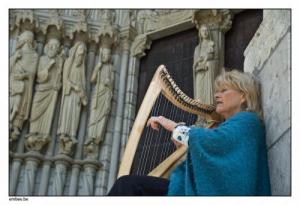 J: And imagine it being sung with the harp that was used at that time.
J: And imagine it being sung with the harp that was used at that time.
A: So it was more of a direct transmission.
J: Yes, it was direct. And Plato writes about the Homeric Singers and about how as they sang, tears would leap out of their eyes and their hair would stand on end. What I just recited was one of the ancient modes.
A: That is where the magic is, with the resonance of the ancient language, and the speaker or singer having the connection with the true meaning of the words, and then the delivery of that potency.
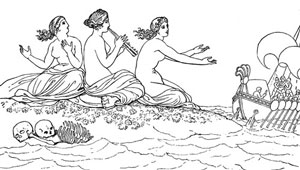
J: So the transmission was sung, there was cadence, it had different levels of ascent and descent, and going into the minor keys. There were ways in which sacred sound would activate all manner of pattern and power. And you think of the great projective languages—Hebrew, old Sanskrit, Javanese and others. They were not simply languages in themselves, they were projected sounds, so that you would read the language…here, let me give you an example:
In the beginning, God created…the opening line in Genesis. In the Hebrew, Bershit, Berach, Elohim: Bershit is very badly translated. In the beginning is not what it means. It means patterns. Berach of creation. Elohim, God or Allah…Lammed Hey: To sluice or channel through life. Yod Mem: The containment in space and time, or the patterns of creation.
(Jean proceeded to recite an old Hebrew prayer saying originally it would have sounded very different and would have included certain cadences and movements of the body.)
A: So, there is no separation from the rhythm, the movement, the sound.
J: They are all one.
A: I have a Tibetan teacher who once said that in the language preceding Sanskrit, that people would actually create the article mentioned by the syllables, just by uttering the sounds.
J: Yes, the Bijas, seed syllables themselves….OM AH HUM.
A: At one time I had sent your husband one of my CDs Medicine Song II, containing a chant to Sekhmet, using the Egyptian syllables SA SEKHEM SAHU.
(Robert Masters, husband of Jean, a brilliant teacher and mentor for many people, wrote numerous books including The Goddess Sekhmet—Psycho-spiritual exercises of the Fifth Way. Sekhmet is the Egyptian lion-headed mother goddess. At the time of our interview, Robert had recently passed away and across the room was a lovely memorial to his rich and adventurous life with our lady Sekhmet in the center, place of honor.)
J: Really? Because I use that chant to open every Mystery School session.
A: How wonderful…I didn’t know that. We recorded this version in the acoustically resonant temple of Abydos, with harp, Egyptian flute and a choir of voices. And I sent this to Robert to bring the chant full circle and to thank him. Could you speak of the use of art and music in bringing us to that deeper resonance.
J: Art activates the creative impulse in the brain-body-mind system, which to me is the God Impulse. It opens the portals of both our inward as well as our outer sensory systems. We are no longer encapsulated bags of skin dragging around dreary little egos. With art and music we become an organizing environment, our frequencies are raised. And we become re-frequenced with regard to world and time. And that is why the artist and musician often is the one who tells the emerging story, because their frequencies and their sensitivities have been honed and heightened to the point that they are picking up the rhythms of awakening.
In the field I invented, which I call Social Artistry, it is the artistry in which one brings the skill, the focus, passion, the commitment, the failure, the discovery that a good artist brings to his/her material. And in this case, the material is the social canvas. As you look at whole societies, you can see how you can affect them, help them evolve. That is what I try to do in working with leadership all over the world. This is the critical moment in history.

